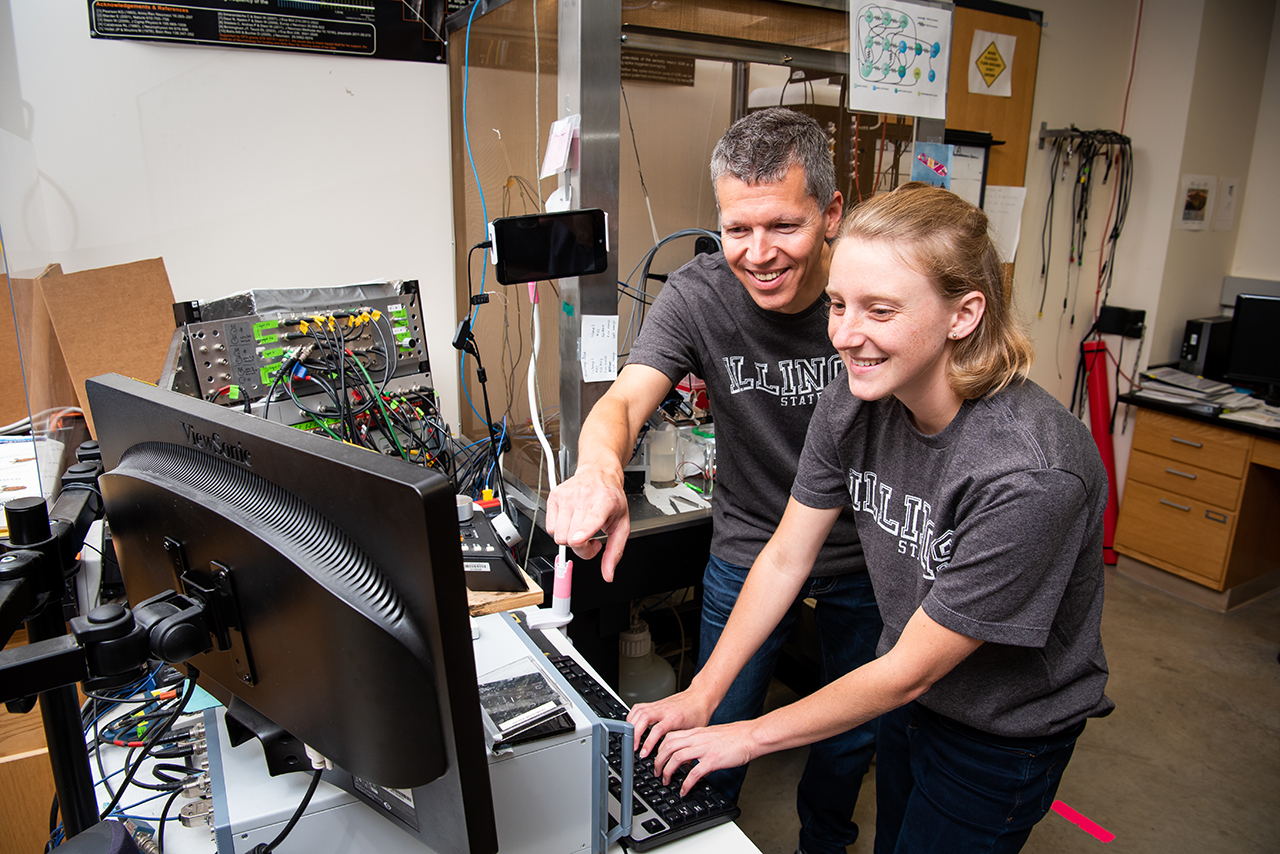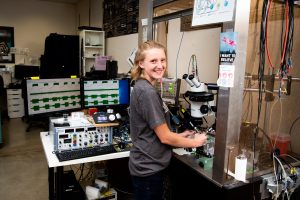Doctoral student Margaret DeMaegd was the first Illinois State student to be invited to the internationally renowned Neural Systems and Behavior course (NS&B) at the Marine Biology Laboratory in Woods Hole, Massachusetts.
DeMaegd’s presentations during the course landed her an invitation to research at the Janelia Research Campus, Howard Hughes Medical Institute’s pioneering research center in Ashburn, Virginia.
DeMaegd spent eight weeks at the NS&B course, from May 30 to July 26. The course consisted of intensive laboratory and lecture time. DeMaegd was one of only 20 students worldwide selected to attend.
“The course is one of the highest graded neuroscience courses by the National Institute of Health (NIH) standards,” said Illinois State Professor of Neurophysiology Wolfgang Stein. “It is really competitive to get in.”
Stein, who previously taught for the NS&B course, supervises DeMaegd’s work as a Ph.D. student in his laboratory. Stein’s Crablab studies the nervous system of the crab to examine how sensory processing affects motor networks and behavior. DeMaegd has worked in Stein’s lab for almost four years researching how sensory information is processed inside of neurons.
“I like the brain. There’s a phrase that says the human brain is one of the only things that seeks to understand itself. I like the idea that there’s this structure that all of us live with all the time and we know so little about.”—Margaret DeMaegd
During the NS&B course, each student was assigned a partner and two faculty members. Every two weeks students received a new organism to examine and gave presentations about the experiment they designed and the organism that they tested. DeMaegd studied multiple organisms in the course, including electric fish, rats, and fruit flies. When studying each organism, the main objective was to look at how sensory and motor nervous systems interacted with one another within the organism and the world.
“I got to work with a rat’s somatosensory cortex and look at cells in the brain,” DeMaegd said. “I had the opportunity to do techniques at the course that we don’t do here, as we aren’t specialists in those kinds of techniques.”
DeMaegd’s partner at the NS&B course was Illinois State alumna Alexandra Yarger, M.S. ’15, who was a master’s student in Stein’s lab.
One of the research projects the two worked on determined how the brain tells the difference between approaching objects on a collision course from those not on a collision course. To investigate, the pair used 2,000 fruit flies and studied the flies’ attempts to land upon or take off from oncoming objects.
While presenting their work, DeMaegd and Yarger were approached by Gwyneth Card, group leader of the Janelia Research Campus. Card applauded their work and invited the pair to Janelia to further their fruit fly research more in depth.
With a $5,000 research grant from the Marine Biology Laboratory and the Grass Foundation, DeMaegd and Yarger stayed at Janelia from August 11 to August 25, continuing their research analyzing the fly’s behavior and its nervous system. The two are currently analyzing the behavioral-based data from their research and are hoping to create a manuscript for publication in the Journal of Experimental Biology. If published, the article would be DeMaegd’s sixth publication in her collegiate career.
DeMaegd credits the NS&B course for giving her new techniques to effectively communicate information while mentoring the undergraduates studying in Stein’s Crablab.
“I would have potentially been able to do this before, but I am much more confident about it now than I was before I went to the course,” said DeMaegd. “I can explain why we’re doing something and why it is important that we do it that particular way whereas before I would think, ‘We’re doing it this way because this is how we do it.’”
DeMaegd plans to do postdoctoral research after graduation. Her goal is to one day lead her own research lab and to work with students.
DeMaegd explained why she chose to study neuroscience: “I like the brain. There’s a phrase that says the human brain is one of the only things that seeks to understand itself. I like the idea that there’s this structure that all of us live with all the time and we know so little about.”
Stein discussed the importance of student research on campus and its impact on students’ futures.
“We emphasize mentoring students in research because it prepares them well for their future careers,” said Stein.


